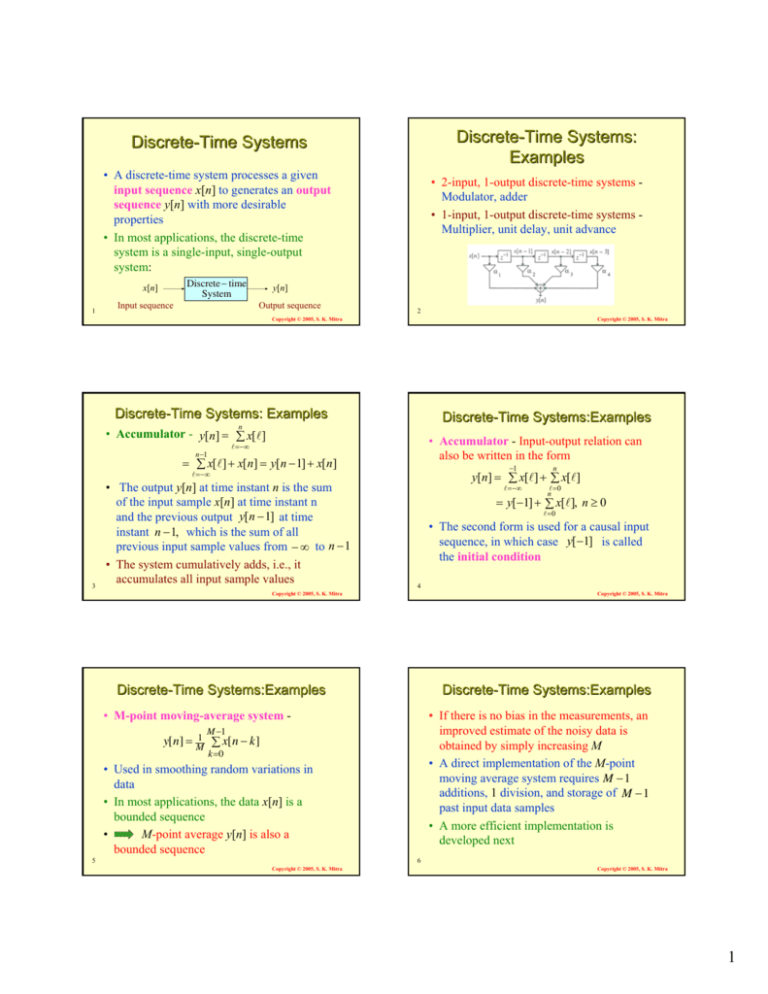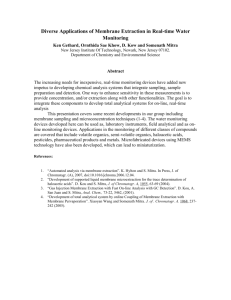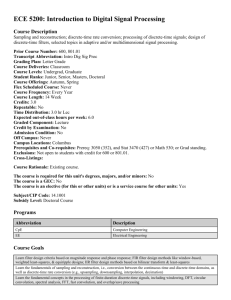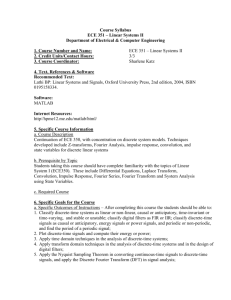Discrete-Time Systems Discrete
advertisement

Discrete-Time Systems:
Examples
Discrete-Time Systems
• A discrete-time system processes a given
input sequence x[n] to generates an output
sequence y[n] with more desirable
properties
• In most applications, the discrete-time
system is a single-input, single-output
system:
Discrete− time
System
x[n]
1
Input sequence
• 2-input, 1-output discrete-time systems Modulator, adder
• 1-input, 1-output discrete-time systems Multiplier, unit delay, unit advance
y[n]
Output sequence
2
Copyright © 2005, S. K. Mitra
Copyright © 2005, S. K. Mitra
DiscreteDiscrete-Time Systems: Examples
DiscreteDiscrete-Time Systems:Examples
n
• Accumulator - y[n] = ∑ x[l]
• Accumulator - Input-output relation can
also be written in the form
l = −∞
n −1
= ∑ x[l] + x[ n] = y[n − 1] + x[n]
3
• The output y[n] at time instant n is the sum
of the input sample x[n] at time instant n
and the previous output y[n − 1] at time
instant n − 1, which is the sum of all
previous input sample values from − ∞ to n − 1
• The system cumulatively adds, i.e., it
accumulates all input sample values
n
l = −∞
l =0
n
= y[−1] + ∑ x[l], n ≥ 0
l=0
• The second form is used for a causal input
sequence, in which case y[−1] is called
the initial condition
4
Copyright © 2005, S. K. Mitra
Copyright © 2005, S. K. Mitra
DiscreteDiscrete-Time Systems:Examples
DiscreteDiscrete-Time Systems:Examples
• M-point moving-average system -
• If there is no bias in the measurements, an
improved estimate of the noisy data is
obtained by simply increasing M
• A direct implementation of the M-point
moving average system requires M − 1
additions, 1 division, and storage of M − 1
past input data samples
• A more efficient implementation is
developed next
M −1
1
y[ n] = M
∑ x[ n − k ]
k =0
• Used in smoothing random variations in
data
• In most applications, the data x[n] is a
bounded sequence
•
M-point average y[n] is also a
bounded sequence
5
−1
y[n] = ∑ x[l] + ∑ x[l]
l = −∞
6
Copyright © 2005, S. K. Mitra
Copyright © 2005, S. K. Mitra
1
DiscreteDiscrete-Time Systems:Examples
DiscreteDiscrete-Time Systems:Examples
1 ⎛ M −1
⎜ ∑ x[ n − l] +
M⎝
l =0
1⎛ M
⎞
x[ n − M ] − x[ n − M ] ⎟
⎠
⎞
= ⎜ ∑ x[ n − l] + x[ n] − x[ n − M ] ⎟
M⎝
⎠
l =1
M
−
1
⎞
1⎛
= ⎜ ∑ x[ n − 1 − l] + x[ n] − x[ n − M ] ⎟
M⎝
⎠
l =0
Hence
y[ n] =
y[ n] = y[ n − 1] +
• Computation of the modified M-point
moving average system using the recursive
equation now requires 2 additions and 1
division
• An application: Consider
x[n] = s[n] + d[n],
where s[n] is the signal corrupted by a noise
d[n]
1
( x[ n] − x[ n − M ])
M
7
8
Copyright © 2005, S. K. Mitra
Copyright © 2005, S. K. Mitra
DiscreteDiscrete-Time Systems:Examples
DiscreteDiscrete-Time Systems:Examples
s[ n] = 2[n(0.9) ], d[n] - random signal
n
• Exponentially Weighted Running Average
Filter
y[ n] = αy[ n − 1] + x[ n], 0 < α < 1
8
d[n]
s[n]
x[n]
Amplitude
6
4
2
• Computation of the running average requires
only 2 additions, 1 multiplication and storage
of the previous running average
• Does not require storage of past input data
samples
0
-2
0
10
20
30
Time index n
40
50
7
s[n]
y[n]
6
Amplitude
5
4
3
2
1
9
0
0
10
20
30
Time index n
40
50
10
Copyright © 2005, S. K. Mitra
Copyright © 2005, S. K. Mitra
DiscreteDiscrete-Time Systems:Examples
DiscreteDiscrete-Time Systems:Examples
• Linear interpolation - Employed to estimate
sample values between pairs of adjacent
sample values of a discrete-time sequence
• Factor-of-4 interpolation
• For 0 < α < 1, the exponentially weighted
average filter places more emphasis on current
data samples and less emphasis on past data
samples as illustrated below
y[ n] = α(αy[ n − 2] + x[ n − 1]) + x[ n]
= α 2 y[ n − 2] + αx[ n − 1] + x[ n]
= α 2 (αy[ n − 3] + x[ n − 2]) + αx[ n − 1] + x[ n]
y[n]
= α3 y[ n − 3] + α 2 x[ n − 2] + αx[ n − 1] + x[ n]
3
11
12
Copyright © 2005, S. K. Mitra
0
1
2
4
5
6
7
8
9
10
11
12
n
Copyright © 2005, S. K. Mitra
2
Discrete-Time Systems:
Examples
Discrete-Time Systems:
Examples
• Factor-of-2 interpolator -
• Factor-of-2 interpolator y[n] = xu [ n] + 1 ( xu [n − 1] + xu [n + 1])
2
• Factor-of-3 interpolator y[n] = xu [n] + 1 ( xu [n − 1] + xu [ n + 2])
3
+ 2 ( xu [n − 2] + xu [n + 1])
3
13
Original ( 512×512 )
Down −sampled
( 256×256 )
Interpolated ( 512 × 512 )
14
Copyright © 2005, S. K. Mitra
Copyright © 2005, S. K. Mitra
Discrete-Time Systems:
Examples
Discrete-Time Systems:
Examples
Median Filter –
• The median of a set of (2K+1) numbers is
the number such that K numbers from the
set have values greater than this number and
the other K numbers have values smaller
• Median can be determined by rank-ordering
the numbers in the set by their values and
choosing the number at the middle
15
Median Filter –
• Example: Consider the set of numbers
{2, − 3, 10, 5, − 1}
• Rank-order set is given by
{− 3, − 1, 2, 5, 10}
• Hence,
med{2, − 3, 10, 5, − 1} = 2
16
Copyright © 2005, S. K. Mitra
Copyright © 2005, S. K. Mitra
Discrete-Time Systems:
Examples
Discrete-Time Systems:
Examples
Median Filter –
• Implemented by sliding a window of odd
length over the input sequence {x[n]} one
sample at a time
• Output y[n] at instant n is the median value
of the samples inside the window centered
at n
17
Median Filter –
• Finds applications in removing additive
random noise, which shows up as sudden
large errors in the corrupted signal
• Usually used for the smoothing of signals
corrupted by impulse noise
18
Copyright © 2005, S. K. Mitra
Copyright © 2005, S. K. Mitra
3
Discrete-Time Systems:
Examples
Discrete-Time Systems:
Classification
Median Filtering Example –
•
•
•
•
•
19
Linear System
Shift-Invariant System
Causal System
Stable System
Passive and Lossless Systems
20
Copyright © 2005, S. K. Mitra
Copyright © 2005, S. K. Mitra
Linear Discrete-Time Systems
Linear Discrete-Time Systems
n
• Definition - If y1[ n] is the output due to an
input x1[n] and y2 [n] is the output due to an
input x2 [n] then for an input
x[n] = α x1[n] + β x2 [n]
the output is given by
y[n] = α y1[n] + β y2 [n]
21
• Above property must hold for any arbitrary
constants α and β , and for all possible
inputs x1[n] and x2 [n]
n
• Accumulator - y1[n] = ∑ x1[l], y2 [n] = ∑ x2 [l]
l = −∞
l = −∞
For an input
x[n] = α x1[n] + β x2 [n]
the output is
n
y[n] = ∑ (α x1[l] + β x2 [l])
l = −∞
n
n
l = −∞
l = −∞
= α ∑ x1[l] + β ∑ x2 [l] = α y1[n] + β y2 [n]
• Hence, the above system is linear
22
Copyright © 2005, S. K. Mitra
Copyright © 2005, S. K. Mitra
Linear Discrete-Time Systems
Linear Discrete-Time Systems
• The outputs y1[n] and y2 [n] for inputs x1[n]
and x2 [n] are given by n
y1[n] = y1[−1] + ∑ x1[l]
y2 [n] = y2 [−1] +
• Now α y1[n] + β y2 [n]
= α ( y1[−1] +
l =0
n
∑ x2 [l]
y[n] = y[−1] +
∑ (α x1[l] + β x 2 [l])
Copyright © 2005, S. K. Mitra
l =0
n
n
l =0
∑ x2 [l])
l =0
• Thus y[n] = α y1[n] + β y2 [n] if
n
l =0
l =0
= (α y1[−1] + β y2 [−1]) + (α ∑ x1[l] + β
l =0
• The output y[n] for an input α x1[n] + β x 2 [n]
is given by
23
n
n
∑ x1[l]) + β ( y2 [−1] + ∑ x2 [l])
y[−1] = α y1[−1] + β y2 [−1]
24
Copyright © 2005, S. K. Mitra
4
Nonlinear Discrete-Time
System
Linear Discrete-Time System
25
• For the causal accumulator to be linear the
condition y[−1] = α y1[−1] + β y2 [−1]
must hold for all initial conditions y[−1],
y1[−1] , y2 [−1] , and all constants α and β
• This condition cannot be satisfied unless the
accumulator is initially at rest with zero
initial condition
• For nonzero initial condition, the system is
nonlinear
26
• The median filter described earlier is a
nonlinear discrete-time system
• To show this, consider a median filter with
a window of length 3
• Output of the filter for an input
{x1[ n]} = {3, 4, 5}, 0 ≤ n ≤ 2
is
{y1[ n]} = {3, 4, 4}, 0 ≤ n ≤ 2
Copyright © 2005, S. K. Mitra
Copyright © 2005, S. K. Mitra
Nonlinear Discrete-Time
System
Nonlinear Discrete-Time
System
• Output for an input
{x2 [ n]} = {2, − 1, − 1}, 0 ≤ n ≤ 2
is
• Note
{y1[ n] + y2 [ n]} = {3, 3, 3} ≠ {y[ n]}
{y2 [ n]} = {0, − 1, − 1}, 0 ≤ n ≤ 2
• Hence, the median filter is a nonlinear
discrete-time system
• However, the output for an input
{x[ n]} = {x1[ n] + x2 [ n]}
is
{y[ n]} = {3, 4, 3}
27
28
Copyright © 2005, S. K. Mitra
Copyright © 2005, S. K. Mitra
Shift-Invariant System
Shift-Invariant System
• For a shift-invariant system, if y1[n] is the
response to an input x1[n], then the response
to an input
x[n] = x1[n − no ]
is simply
y[n] = y1[n − no ]
29
where no is any positive or negative integer
• The above relation must hold for any
arbitrary input and its corresponding output
Copyright © 2005, S. K. Mitra
• In the case of sequences and systems with
indices n related to discrete instants of time,
the above property is called time-invariance
property
• Time-invariance property ensures that for a
specified input, the output is independent of
the time the input is being applied
30
Copyright © 2005, S. K. Mitra
5
Shift-Invariant System
Shift-Invariant System
• Example - Consider the up-sampler with an
input-output relation given by
x[n / L], n = 0, ± L, ± 2 L, .....
xu [n] = ⎧⎨
otherwise
⎩ 0,
31
• For an input x1[n] = x[n − no ] the output x1,u [n]
is given by
x [n / L], n = 0, ± L, ± 2 L, .....
x1,u [n] = ⎧⎨ 1
otherwise
⎩ 0,
x
[(
n
−
Ln
)
/
L
],
n = 0, ± L, ± 2 L, .....
o
= ⎧⎨
0
,
otherwise
⎩
Copyright © 2005, S. K. Mitra
• However from the definition of the up-sampler
xu [n − no ]
x[(n − no ) / L], n = no , no ± L, no ± 2L, .....
= ⎧⎨
0,
otherwise
⎩
≠ x1,u [n]
• Hence, the up-sampler is a time-varying system
32
Copyright © 2005, S. K. Mitra
Linear Time-Invariant System
Causal System
• Linear Time-Invariant (LTI) System A system satisfying both the linearity and
the time-invariance property
• LTI systems are mathematically easy to
analyze and characterize, and consequently,
easy to design
• Highly useful signal processing algorithms
have been developed utilizing this class of
systems over the last several decades
• In a causal system, the no -th output sample
y[no ] depends only on input samples x[n]
for n ≤ no and does not depend on input
samples for n > no
• Let y1[n] and y2 [n] be the responses of a
causal discrete-time system to the inputs x1[n]
and x2 [n] , respectively
33
34
Copyright © 2005, S. K. Mitra
Copyright © 2005, S. K. Mitra
Causal System
Causal System
• Examples of causal systems:
y[n] = α1x[n] + α 2 x[n − 1] + α 3 x[n − 2] + α 4 x[n − 3]
• Then
y[n] = b0 x[n] + b1x[n − 1] + b2 x[n − 2]
+ a1 y[n − 1] + a2 y[n − 2]
y[n] = y[n − 1] + x[n]
x1[n] = x2[n] for n < N
implies also that
y1[n] = y2[n] for n < N
• For a causal system, changes in output
samples do not precede changes in the input
samples
35
• Examples of noncausal systems:
1
y[n] = xu [n] + ( xu [n − 1] + xu [n + 1])
2
1
36
Copyright © 2005, S. K. Mitra
y[n] = xu [n] + ( xu [n − 1] + xu [n + 2])
3
2
+ ( xu [n − 2] + xu [n + 1])
3
Copyright © 2005, S. K. Mitra
6
Stable System
Causal System
• There are various definitions of stability
• We consider here the bounded-input,
bounded-output (BIBO) stability
• If y[n] is the response to an input x[n] and if
x[n] ≤ Bx for all values of n
then
y[n] ≤ B y for all values of n
• A noncausal system can be implemented as
a causal system by delaying the output by
an appropriate number of samples
• For example a causal implementation of the
factor-of-2 interpolator is given by
1
2
y[n] = xu [n − 1] + ( xu [n − 2] + xu [n])
37
38
Copyright © 2005, S. K. Mitra
Copyright © 2005, S. K. Mitra
Stable System
Passive and Lossless Systems
• Example - The M-point moving average
filter is BIBO stable:
y[n] =
1
M
• A discrete-time system is defined to be
passive if, for every finite-energy input x[n],
the output y[n] has, at most, the same energy,
i.e.
M −1
∑ x[n − k ]
k =0
• For a bounded input x[n] ≤ Bx we have
y[n] =
≤
1
M
1
M
M −1
∑ x[n − k ] ≤
k =0
1
M
∑ x[n − k ]
k =0
n = −∞
n = −∞
40
Copyright © 2005, S. K. Mitra
Copyright © 2005, S. K. Mitra
Impulse and Step Responses
Passive and Lossless Systems
• The response of a discrete-time system to a
unit sample sequence {δ[n]} is called the
unit sample response or simply, the
impulse response, and is denoted by {h[n]}
• The response of a discrete-time system to a
unit step sequence {µ[n]} is called the unit
step response or simply, the step response,
and is denoted by {s[n]}
• Example - Consider the discrete-time
system defined by y[n] = α x[n − N ] with N
a positive integer
• Its output energy is given by
∞
2
∑ y[n] = α
n = −∞
41
∞
• For a lossless system, the above inequality is
satisfied with an equal sign for every input
( MBx ) ≤ Bx
39
∞
2
2
∑ y[n] ≤ ∑ x[n] < ∞
M −1
2 ∞
∑ x[n]
2
n = −∞
• Hence, it is a passive system if α < 1 and is
a lossless system if α = 1
Copyright © 2005, S. K. Mitra
42
Copyright © 2005, S. K. Mitra
7
Impulse Response
Impulse Response
• Example - The impulse response of the
system
y[n] = α1x[n] + α 2 x[n − 1] + α 3 x[n − 2] + α 4 x[n − 3]
43
is obtained by setting x[n] = δ[n] resulting
in
h[n] = α1δ [n] + α 2δ [n − 1] + α 3δ [n − 2] + α 4δ [n − 3]
• The impulse response is thus a finite-length
sequence of length 4 given by
{h[n]} = {α1, α 2 , α 3 , α 4}
↑
• Example - The impulse response of the
discrete-time accumulator
y[n] =
l = −∞
is obtained by setting x[n] = δ[n] resulting
in
n
h[n] = ∑ δ [l] = µ [n]
l = −∞
44
Copyright © 2005, S. K. Mitra
Copyright © 2005, S. K. Mitra
Time-Domain Characterization
of LTI Discrete-Time System
Impulse Response
• Example - The impulse response {h[n]} of
the factor-of-2 interpolator
1
y[n] = xu [n] + ( xu [n − 1] + xu [n + 1])
2
• is obtained by setting xu [n] = δ [n] and is
given by
1
h[n] = δ [n] + (δ [n − 1] + δ [n + 1])
• Input-Output Relationship A consequence of the linear, timeinvariance property is that an LTI discretetime system is completely characterized by
its impulse response
•
Knowing the impulse response one
can compute the output of the system for
any arbitrary input
2
45
n
∑ x[l]
• The impulse response is thus a finite-length
sequence of length 3:
{h[n]} = {0.5, 1 0.5}
↑
46
Copyright © 2005, S. K. Mitra
Copyright © 2005, S. K. Mitra
Time-Domain Characterization
of LTI Discrete-Time System
Time-Domain Characterization
of LTI Discrete-Time System
• Let h[n] denote the impulse response of a
LTI discrete-time system
• We compute its output y[n] for the input:
• Since the system is time-invariant
input
output
δ[n + 2] → h[n + 2]
x[ n] = 0.5δ[ n + 2] + 1.5δ[n − 1] − δ[ n − 2] + 0.75δ[ n − 5]
δ[n − 1] → h[n − 1]
• As the system is linear, we can compute its
outputs for each member of the input
separately and add the individual outputs to
determine y[n]
δ[n − 2] → h[n − 2]
47
δ[n − 5] → h[n − 5]
48
Copyright © 2005, S. K. Mitra
Copyright © 2005, S. K. Mitra
8
Time-Domain Characterization
of LTI Discrete-Time System
Time-Domain Characterization
of LTI Discrete-Time System
• Likewise, as the system is linear
input
49
• Now, any arbitrary input sequence x[n] can
be expressed as a linear combination of
delayed and advanced unit sample
sequences in the form
output
0.5δ[n + 2] → 0.5h[n + 2]
1.5δ[n − 1] → 1.5h[n − 1]
− δ[n − 2] → − h[n − 2]
0.75δ[n − 5] → 0.75h[n − 5]
• Hence because of the linearity property we
get
y[n] = 0.5h[n + 2] + 1.5h[n − 1]
− h[n − 2] + 0.75h[n − 5]
∞
x[n] = ∑ x[k ] δ[n − k ]
k = −∞
• The response of the LTI system to an input
x[ k ] δ[n − k ] will be x[k ] h[n − k ]
50
Copyright © 2005, S. K. Mitra
Copyright © 2005, S. K. Mitra
Time-Domain Characterization
of LTI Discrete-Time System
Convolution Sum
• Hence, the response y[n] to an input
• The summation
∞
x[ n] = ∑ x[k ] δ[ n − k ]
y[n] =
k = −∞
will be
∞
k = −∞
which can be alternately written as
51
∞
k = −∞
k = −∞
y[n] = x[n] * h[n]
∑ x[n − k ] h[k ]
k = −∞
∞
is called the convolution sum of the
sequences x[n] and h[n] and represented
compactly as
y[n] = ∑ x[k ] h[ n − k ]
y[n] =
∞
∑ x[k ] h[n − k ] = ∑ x[n − k ] h[n]
52
Copyright © 2005, S. K. Mitra
Copyright © 2005, S. K. Mitra
Convolution Sum
Convolution Sum
• Properties • Commutative property:
x[n] * h[n] = h[n] * x[n]
• Associative property :
(x[n] * h[n]) * y[n] = x[n] * (h[n] * y[n])
• Distributive property :
x[n] * (h[n] + y[n]) = x[n] * h[n] + x[n] * y[n]
53
54
Copyright © 2005, S. K. Mitra
• Interpretation • 1) Time-reverse h[k] to form h[− k ]
• 2) Shift h[− k ] to the right by n sampling
periods if n > 0 or shift to the left by n
sampling periods if n < 0 to form h[n − k ]
• 3) Form the product v[k ] = x[k ]h[n − k ]
• 4) Sum all samples of v[k] to develop the
n-th sample of y[n] of the convolution sum
Copyright © 2005, S. K. Mitra
9
Convolution Sum
Convolution Sum
• Schematic Representation h[− k ]
zn
h[n − k ] v[k ]
∑
×
y[n]
k
x[k ]
55
• The computation of an output sample using
the convolution sum is simply a sum of
products
• Involves fairly simple operations such as
additions, multiplications, and delays
56
• We illustrate the convolution operation for
the following two sequences:
⎧1, 0 ≤ n ≤ 5
x[ n] = ⎨
⎩0, otherwise
⎧1.8 − 0.3n, 0 ≤ n ≤ 5
h[ n] = ⎨
0,
otherwise
⎩
• Figures on the next several slides the steps
involved in the computation of
y[n] = x[n] * h[n]
Copyright © 2005, S. K. Mitra
Copyright © 2005, S. K. Mitra
Convolution Sum
Convolution Sum
Plot of x[-4- k] and h[k]
h[k]x[-4- k]
2
3
Amplitude
Amplitude
1.5
1
0.5
0
-0.5
-10
2
1
0
0
10
k→
-10
6
6
Amplitude
Amplitude
57
y[n]
8
4
2
0
-10
0
10 k →
0
y[-4]
8
4
2
0
-10
10
0
n
58
10
n
Copyright © 2005, S. K. Mitra
Copyright © 2005, S. K. Mitra
Convolution Sum
3
Amplitude
1
0.5
0
1
1
0.5
0
k→
-10
0
10
y[n]
-0.5
-10
k→
2
1
0
0
10
y[0]
-10
k→
8
8
6
6
6
6
2
0
-10
0
10
n
4
2
0
-10
0
60
Copyright © 2005, S. K. Mitra
4
2
0
-10
10
n
Amplitude
8
4
0
10
n
0
10
y[n]
8
Amplitude
Amplitude
10
3
1.5
2
0
0
y[-1]
h[k]x[0- k]
2
Amplitude
Amplitude
1.5
59
Plot of x[0- k] and h[k]
Amplitude
2
-0.5
-10
Convolution Sum
h[k]x[-1- k]
Amplitude
Plot of x[-1- k] and h[k]
k→
4
2
0
-10
0
10
n
Copyright © 2005, S. K. Mitra
10
Convolution Sum
h[k]x[1- k]
Amplitude
0.5
0
10
y[1]
1
-10
k→
3
1
0.5
0
0
10
y[n]
-0.5
-10
k→
2
1
0
0
10
y[3]
-10
k→
8
8
6
6
6
6
2
0
-10
0
4
2
0
-10
10
0
n
61
4
2
0
-10
10
n
Amplitude
8
4
0
0
2
0
-10
10
0
10
n
Copyright © 2005, S. K. Mitra
Copyright © 2005, S. K. Mitra
Convolution Sum
h[k]x[5- k]
0
2
1
10
y[5]
-10
k→
3
1
0.5
0
0
0
h[k]x[7- k]
2
1.5
Amplitude
Amplitude
0
10
y[n]
-0.5
-10
k→
2
1
0
0
10
k→
-10
6
6
6
6
2
0
-10
0
2
0
-10
10
0
n
63
4
2
0
-10
10
n
Amplitude
8
Amplitude
8
4
0
2
0
-10
10
0
10
n
Copyright © 2005, S. K. Mitra
Copyright © 2005, S. K. Mitra
Convolution Sum
3
Amplitude
1
0.5
0
10
y[9]
1
0.5
0
0
10
y[n]
-0.5
-10
k→
2
1
0
0
y[10]
10
-10
k→
8
8
6
6
6
6
2
0
-10
0
10
n
4
2
0
-10
0
66
Copyright © 2005, S. K. Mitra
4
2
0
-10
10
n
Amplitude
8
4
0
10
n
0
10
y[n]
8
Amplitude
Amplitude
1
-10
k→
3
1.5
2
0
0
h[k]x[10- k]
2
Amplitude
Amplitude
1.5
65
Plot of x[10- k] and h[k]
Amplitude
2
-0.5
-10
Convolution Sum
h[k]x[9- k]
Amplitude
Plot of x[9- k] and h[k]
k→
4
n
64
10
y[n]
8
4
0
y[7]
8
Amplitude
Amplitude
1
Amplitude
Plot of x[7- k] and h[k]
3
0.5
-0.5
-10
Convolution Sum
Amplitude
Plot of x[5- k] and h[k]
2
1.5
k→
4
n
62
10
y[n]
8
Amplitude
Amplitude
2
0
0
h[k]x[3- k]
2
1.5
Amplitude
Amplitude
1
-0.5
-10
Plot of x[3- k] and h[k]
3
Amplitude
2
1.5
Amplitude
Plot of x[1- k] and h[k]
Convolution Sum
k→
4
2
0
-10
0
10
n
Copyright © 2005, S. K. Mitra
11
Convolution Sum
Convolution Sum
h[k]x[12- k]
0.5
0
2
1
0
y[12]
10
-10
k→
3
1
0.5
0
0
-0.5
-10
h[k]x[13- k]
2
1.5
Amplitude
Amplitude
0
10
-0.5
-10
k→
y[n]
2
1
0
0
y[13]
10
k→
-10
8
6
6
6
6
2
0
-10
0
10
4
2
0
-10
n
67
0
4
2
0
-10
10
n
68
Amplitude
8
Amplitude
8
4
0
0
10
k→
y[n]
8
Amplitude
Amplitude
1
Amplitude
Plot of x[13- k] and h[k]
3
Amplitude
Plot of x[12- k] and h[k]
2
1.5
4
2
0
-10
10
0
n
10
n
Copyright © 2005, S. K. Mitra
Copyright © 2005, S. K. Mitra
Time-Domain Characterization
of LTI Discrete-Time System
Time-Domain Characterization
of LTI Discrete-Time System
• In practice, if either the input or the impulse
response is of finite length, the convolution
sum can be used to compute the output
sample as it involves a finite sum of
products
• If both the input sequence and the impulse
response sequence are of finite length, the
output sequence is also of finite length
• If both the input sequence and the impulse
response sequence are of infinite length,
convolution sum cannot be used to compute
the output
• For systems characterized by an infinite
impulse response sequence, an alternate
time-domain description involving a finite
sum of products will be considered
69
70
Copyright © 2005, S. K. Mitra
Copyright © 2005, S. K. Mitra
Time-Domain Characterization
of LTI Discrete-Time System
Time-Domain Characterization
of LTI Discrete-Time System
• Example - Develop the sequence y[n]
generated by the convolution of the
sequences x[n] and h[n] shown below
x[n]
• As can be seen from the shifted timereversed version {h[n − k ]} for n < 0, shown
below for n = −3 , for any value of the
sample index k, the k-th sample of either
{x[k]} or {h[n − k ]} is zero
h[n]
3
2
3
1
h[−3 − k ]
1
1
0
2
–1
4
n
3
0
1
n
2
2
1
–1
–6
–2
–5 –4 –3 –2 –1
0
k
–1
71
72
Copyright © 2005, S. K. Mitra
Copyright © 2005, S. K. Mitra
12
Time-Domain Characterization
of LTI Discrete-Time System
Time-Domain Characterization
of LTI Discrete-Time System
• As a result, for n < 0, the product of the k-th
samples of {x[k]} and {h[n − k ]} is always
zero, and hence
y[n] = 0 for n < 0
• Consider now the computation of y[0]
• The sequence
h[ − k ]
2
{h[− k ]} is shown
1
k
on the right
–1
• The product sequence {x[k ]h[−k ]} is plotted
below which has a single nonzero sample
x[0]h[0] for k = 0
x[k ]h[ −k ]
0
–5 –4 –3 –2 –1
73
–2 –1
0
1
2
2
k
3
–2
• Thus y[0] = x[0]h[0] = −2
–3
–6 –5 –4
1
3
74
Copyright © 2005, S. K. Mitra
Copyright © 2005, S. K. Mitra
Time-Domain Characterization
of LTI Discrete-Time System
Time-Domain Characterization
of LTI Discrete-Time System
• For the computation of y[1], we shift {h[−k ]}
to the right by one sample period to form
{h[1 − k ]} as shown below on the left
• The product sequence {x[k ]h[1 − k ]} is
shown below on the right
• To calculate y[2], we form {h[2 − k ]} as
shown below on the left
• The product sequence {x[k ]h[2 − k ]} is
plotted below on the right
–5 –4 –3 –2 –1
1
–2
–1
0
1
2
3
1
2
x[ k ]h[ 2 − k ]
2
0
2
–5 –4 –3
h[ 2 − k ]
x[k ]h[1 − k ]
h[1 − k ]
3
k
1
1
–1
–4 –3 –2
k
1
0
2
3
4
5
k
–3 –2 –1
0
1
2
3
4
5
6
k
–1
–1
–4
75
• Hence, y[1] = x[0]h[1] + x[1]h[0] = −4 + 0 = −4
76
y[2] = x[0]h[2] + x[1]h[1] + x[2]h[0] = 0 + 0 + 1 = 1
Copyright © 2005, S. K. Mitra
Copyright © 2005, S. K. Mitra
Time-Domain Characterization
of LTI Discrete-Time System
Time-Domain Characterization
of LTI Discrete-Time System
• Continuing the process we get
y[3] = x[0]h[3] + x[1]h[2] + x[2]h[1] + x[3]h[0]
= 2 + 0 + 0 +1 = 3
• From the plot of {h[n − k ]} for n > 7 and the
plot of {x[k]} as shown below, it can be
seen that there is no overlap between these
two sequences
• As a result y[n] = 0 for n > 7
y[4] = x[1]h[3] + x[2]h[2] + x[3]h[1] + x[4]h[0]
= 0 + 0 − 2 + 3 =1
y[5] = x[2]h[3] + x[3]h[2] + x[4]h[1]
= −1 + 0 + 6 = 5
y[6] = x[3]h[3] + x[4]h[2] = 1 + 0 = 1
77
y[7] = x[4]h[3] = −3
x[k]
2
1
0
3
1
2
–1
78
Copyright © 2005, S. K. Mitra
h[8 − k ]
3
–2
4
k
1
5
2
3
4
–1
6
7
8
9 10 11
k
Copyright © 2005, S. K. Mitra
13
Time-Domain Characterization
of LTI Discrete-Time System
Time-Domain Characterization
of LTI Discrete-Time System
• Note: The sum of indices of each sample
product inside the convolution sum is equal
to the index of the sample being generated
by the convolution operation
• For example, the computation of y[3] in the
previous example involves the products
x[0]h[3], x[1]h[2], x[2]h[1], and x[3]h[0]
• The sum of indices in each of these
products is equal to 3
• The sequence {y[n]} generated by the
convolution sum is shown below
y[n]
5
3
0
1
1
1
1
7
2
–2 –1
3
4
5
6
8
9
n
–2
–3
–4
79
80
Copyright © 2005, S. K. Mitra
Copyright © 2005, S. K. Mitra
Tabular Method of
Convolution Sum Computation
Time-Domain Characterization
of LTI Discrete-Time System
• Can be used to convolve two finite-length
sequences
• Consider the convolution of {g[n]}, 0 ≤ n ≤ 3 ,
with {h[n]}, 0 ≤ n ≤ 2 , generating the
sequence y[n] = g[n] * h[n]
• Samples of {g[n]} and {h[n]} are then
multiplied using the conventional
multiplication method without any carry
operation
• In the example considered the convolution
of a sequence {x[n]} of length 5 with a
sequence {h[n]} of length 4 resulted in a
sequence {y[n]} of length 8
• In general, if the lengths of the two
sequences being convolved are M and N,
then the sequence generated by the
convolution is of length M + N − 1
81
82
Copyright © 2005, S. K. Mitra
Copyright © 2005, S. K. Mitra
Tabular Method of
Convolution Sum Computation
n:
g[ n ]:
h[ n ]:
y[ n ]:
Tabular Method of
Convolution Sum Computation
0
1
2
3
4
5
g[ 0 ]
g[1]
g[ 2 ]
g[ 3 ]
h[ 0 ]
h[1]
h[ 2 ]
g[ 0 ]h[ 0 ] g[1]h[ 0 ] g[ 2 ]h[ 0 ] g[ 3]h[ 0 ]
g[ 0 ]h[1] g[1]h[1] g[ 2 ]h[1] g[ 3 ]h[1]
g[ 0 ]h[ 2 ] g[1]h[ 2 ] g[ 2 ]h[ 2 ] g[ 3]h[ 2 ]
y[ 0 ]
y[1]
y[ 2 ]
y[ 3 ]
y[ 4 ]
y[ 5 ]
• The samples of {y[n]} are given by
y[0] = g[0]h[ 0]
y[1] = g[1]h[ 0] + g[ 0]h[1]
y[2] = g[2]h[0] + g[1]h[1] + g[0]h[2]
y[3] = g[3]h[0] + g[2]h[1] + g[1]h[2]
y[ 4] = g[3]h[1] + g[2]h[2]
y[5] = g[3]h[2]
• The samples y[n] generated by the
convolution sum are obtained by adding the
entries in the column above each sample
83
84
Copyright © 2005, S. K. Mitra
Copyright © 2005, S. K. Mitra
14
Tabular Method of
Convolution Sum Computation
Tabular Method of
Convolution Sum Computation
• The method can also be applied to convolve
two finite-length two-sided sequences
• In this case, a decimal point is first placed
to the right of the sample with the time
index n = 0 for each sequence
• Next, convolution is computed ignoring the
location of the decimal point
• Finally, the decimal point is inserted
according to the rules of conventional
multiplication
• The sample immediately to the left of the
decimal point is then located at the time
index n = 0
85
86
Copyright © 2005, S. K. Mitra
Copyright © 2005, S. K. Mitra
Simple Interconnection
Schemes
Convolution Using MATLAB
• The M-file conv implements the convolution
sum of two finite-length sequences
a =[− 2 0 1 − 1 3]
• If
• Two simple interconnection schemes are:
• Cascade Connection
• Parallel Connection
b =[1 2 0 -1]
then conv(a,b) yields
[− 2 − 4 1 3 1 5 1 − 3]
87
88
Copyright © 2005, S. K. Mitra
Copyright © 2005, S. K. Mitra
Cascade Connection
Cascade Connection
≡
• Note: The ordering of the systems in the
cascade has no effect on the overall impulse
response because of the commutative
property of convolution
• A cascade connection of two stable systems
is stable
• A cascade connection of two passive
(lossless) systems is passive (lossless)
h1[n]
h2[n]
≡
h2[n]
h1[n]
h1[n] * hh[n]=h2[n] [n]
1
• Impulse response h[n] of the cascade of two
LTI discrete-time systems with impulse
responses h1[n] and h2[n] is given by
h[n] = h1[n] * h2[n]
89
90
Copyright © 2005, S. K. Mitra
Copyright © 2005, S. K. Mitra
15
Cascade Connection
Cascade Connection
• An application of the inverse system
concept is in the recovery of a signal x[n]
from its distorted version xˆ[n] appearing at
the output of a transmission channel
• If the impulse response of the channel is
known, then x[n] can be recovered by
designing an inverse system of the channel
• An application is in the development of an
inverse system
• If the cascade connection satisfies the
relation
h1[n] * h2[n] = δ[n]
then the LTI system h1[n] is said to be the
inverse of h2[n] and vice-versa
91
x[n ]
92
inverse system
channel ^
x[n ]
h1[n]
h2[n]
h1[n] * h 2[n] = δ[ n]
Copyright © 2005, S. K. Mitra
Copyright © 2005, S. K. Mitra
Cascade Connection
Cascade Connection
• Example - Consider the discrete-time
accumulator with an impulse response µ[n]
• Its inverse system satisfy the condition
µ[n] * h 2[n] = δ[n]
• It follows from the above that h2[n] = 0 for
n < 0 and
h2[0] = 1
n
∑ h2[l] = 0
93
• Thus the impulse response of the inverse
system of the discrete-time accumulator is
given by
h2[ n] = δ[n] − δ[n − 1]
which is called a backward difference
system
for n ≥ 1
l =0
94
Copyright © 2005, S. K. Mitra
Copyright © 2005, S. K. Mitra
Simple Interconnection Schemes
Parallel Connection
h1[n]
h2[n]
95
x[n ]
+
≡
• Consider the discrete-time system where
h1[ n] = δ[n] + 0.5δ[n − 1],
h1[n] + hh[n]=h2[n] [n]
1
• Impulse response h[n] of the parallel
connection of two LTI discrete-time
systems with impulse responses h1[n] and
h2[n] is given by
h[n] = h1[n] + h2[n]
Copyright © 2005, S. K. Mitra
h2[ n] = 0.5δ[n] − 0.25δ[n − 1],
h3[n] = 2δ[n],
h4[ n] = −2(0.5) µ[ n]
n
96
h1[n]
+
h3[n]
+
h2[n]
h4[n]
Copyright © 2005, S. K. Mitra
16
Simple Interconnection Schemes
Simple Interconnection Schemes
• Simplifying the block-diagram we obtain
• Overall impulse response h[n] is given by
h[n] = h1[n] + h2[n] * (h3[n] + h4[n])
= h1[n] + h 2[n] * h3[n] + h 2[n] * h 4[n]
• Now,
+
h1[n]
≡
h2[n]
h1[n]
+
h 2[ n ] * ( h3[ n ]+ h 4[ n ])
h 3[ n ] + h 4[ n ]
h2[n] * h3[n] = ( 1 δ[ n] − 1 δ[n − 1]) * 2δ[n]
2
4
= δ[n] − 1 δ[n − 1]
2
97
98
Copyright © 2005, S. K. Mitra
Copyright © 2005, S. K. Mitra
Simple Interconnection Schemes
(
)
h2[n] * h4[n] = ( 1 δ[n] − 1 δ[n − 1]) * − 2( 12 ) n µ[n]
2
• Therefore
4
= − ( 12 ) n µ[ n] + 12 ( 12 ) n −1µ[n − 1]
= − ( 12 ) n µ[ n] + ( 12 ) n µ[n − 1]
= − ( 12 ) n δ[n] = − δ[n]
h[ n] = δ[n] + 12 δ[n − 1] + δ[n] − 12 δ[n − 1] − δ[n] = δ[n]
99
Copyright © 2005, S. K. Mitra
17






